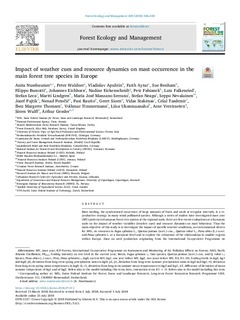Impact of weather cues and resource dynamics on mast occurrence in the main forest tree species in Europe
| dc.contributor.author | Nussbaumer, Anita | |
| dc.contributor.author | Waldner, Peter | |
| dc.contributor.author | Apuhtin, Vladislav | |
| dc.contributor.author | Aytar, Fatih | |
| dc.contributor.author | Benham, Sue | |
| dc.contributor.author | Bussotti, Filippo | |
| dc.contributor.author | Eichhorn, Johannes | |
| dc.contributor.author | Eickenscheidt, Nadine | |
| dc.contributor.author | Fabianek, Petr | |
| dc.contributor.author | Falkenried, Lutz | |
| dc.contributor.author | Leca, Stefan | |
| dc.contributor.author | Lindgren, Martti | |
| dc.contributor.author | Serrano, María José Manzano | |
| dc.contributor.author | Neagu, Stefan | |
| dc.contributor.author | Nevalainen, Seppo | |
| dc.contributor.author | Pajtik, Jozef | |
| dc.contributor.author | Potočić, Nenad | |
| dc.contributor.author | Rautio, Pasi | |
| dc.contributor.author | Sioen, Geert | |
| dc.contributor.author | Stakėnas, Vidas | |
| dc.contributor.author | Tasdemir, Celal | |
| dc.contributor.author | Thomsen, Iben Margrete | |
| dc.contributor.author | Timmermann, Volkmar | |
| dc.contributor.author | Ukonmaanaho, Liisa | |
| dc.contributor.author | Verstraeten, Arne | |
| dc.contributor.author | Wulff, Sören | |
| dc.contributor.author | Gessler, Arthur | |
| dc.date.accessioned | 2018-09-25T08:55:52Z | |
| dc.date.available | 2018-09-25T08:55:52Z | |
| dc.date.created | 2018-08-28T16:26:56Z | |
| dc.date.issued | 2018-07-23 | |
| dc.identifier.citation | Forest Ecology and Management. 2018, 429 336-350. | nb_NO |
| dc.identifier.issn | 0378-1127 | |
| dc.identifier.uri | http://hdl.handle.net/11250/2564290 | |
| dc.description.abstract | Mast seeding, the synchronised occurrence of large amounts of fruits and seeds at irregular intervals, is a reproductive strategy in many wind-pollinated species. Although a series of studies have investigated mast year (MY) patterns in European forest tree species at the regional scale, there are few recent evaluations at a European scale on the impact of weather variables (weather cues) and resource dynamics on mast behaviour. Thus the main objective of this study is to investigate the impact of specific weather conditions, as environmental drivers for MYs, on resources in Fagus sylvatica L., Quercus petraea (Matt.)Liebl., Quercus robur L., Picea abies (L.) Karst. and Pinus sylvestris L. at a European level and to explore the robustness of the relationships in smaller regions within Europe. Data on seed production originating from the International Co-operative Programme on Assessment and Monitoring of Air Pollution Effects on Forests (ICP Forests) were analysed. Three beta regression models were applied to investigate the impact of seasonal weather variables on MY occurrence, as well as the influence of fruiting intensity levels in the years prior to MYs. Resource dynamics are analysed at three different spatial scales (continent, countries and ecoregions). At a European scale, important weather cues for beech MYs were a cold and wet summer two years before a MY, a dry and warm summer one year before a MY and a warm spring in the MY. For spruce, a cold and dry summer two years prior to a MY and a warm and dry summer in the year before the MY showed the strongest associations with the MY. For oak, high spring temperature in the MY was the most important weather cue. For beech and spruce, and to some extent also for oak species, the best fitting models at European scale were well reflected by those found at smaller scales. For pine, best fitting models were highly diverse concerning weather cues. Fruiting levels were high in all species two years before the MY and also high one year before the MY in the oak species and in pine. In beech, fruiting levels one year before the MY were not important and in spruce, they were inconsistent depending on the region. As a consequence, evidence of resource depletion could only be seen in some regions for spruce. | nb_NO |
| dc.language.iso | eng | nb_NO |
| dc.rights | Navngivelse 4.0 Internasjonal | * |
| dc.rights.uri | http://creativecommons.org/licenses/by/4.0/deed.no | * |
| dc.title | Impact of weather cues and resource dynamics on mast occurrence in the main forest tree species in Europe | nb_NO |
| dc.type | Journal article | nb_NO |
| dc.type | Peer reviewed | nb_NO |
| dc.description.version | publishedVersion | nb_NO |
| dc.rights.holder | Crown Copyright © 2018 | nb_NO |
| dc.subject.nsi | VDP::Landbruks- og Fiskerifag: 900 | nb_NO |
| dc.source.pagenumber | 336-350 | nb_NO |
| dc.source.volume | 429 | nb_NO |
| dc.source.journal | Forest Ecology and Management | nb_NO |
| dc.identifier.doi | 10.1016/j.foreco.2018.07.011 | |
| dc.identifier.cristin | 1605076 | |
| cristin.ispublished | true | |
| cristin.fulltext | original | |
| cristin.qualitycode | 1 |
Tilhørende fil(er)
Denne innførselen finnes i følgende samling(er)
-
Divisjon for bioteknologi og plantehelse [532]
Publikasjoner knyttet til ansatte ved Divisjon for bioteknologi og plantehelse -
Publikasjoner fra CRIStin - NIBIO [4575]
-
Vitenskapelige artikler [1416]

